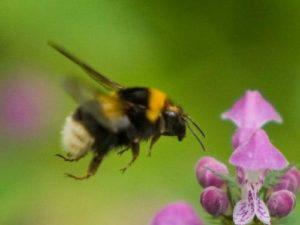How a bumblebee flies: the forces of nature and the laws of aerodynamics
One of the most common types of bees is the bumblebee. Furry and noisy, the insect has small wings compared to its body proportions. According to the laws of aerodynamics, the flight of an insect with such parameters is simply impossible. For a long time, scientists have been doing research to understand how this is possible.
Content
The structure of the wings of a bumblebee in comparison with an airplane
There is a whole science - bionics, a science that combines technology and biology. She studies various organisms and what people can extract from them for themselves.
People often take something from nature and study it carefully. But the bumblebee haunted scientists for a long time, or rather its ability to fly.
Physicists have found that the aircraft flies due to the complex design of the wing and the aerodynamic surface. Effective lift is provided by the rounded leading edge of the wing and the steep trailing edge. Engine thrust power is 63300 lbs.
The aerodynamics of the flight of an airplane and a bumblebee should be the same. Scientists have proven that according to the laws of physics, bumblebees should not fly. However, it is not.
Bumblebee wings are capable of creating more lift than scientists expect. If the plane had the proportions of a bumblebee, then it would not take off from the ground. An insect can be compared to a helicopter with flexible blades.
After testing the theory applicable to the Boeing 747 with respect to bumblebees, physicists found that the wingspan is from 300 to 400 flaps in 1 second. This is possible due to the contraction and relaxation of the abdominal muscles.
The painted patterns of the wings during flapping are the cause of various aerodynamic forces. They contradict any mathematical theory. The wings are not able to swing like a door on a normal hinge. The upper part creates a thin oval. The wings can flip with each stroke, pointing the top upwards on a downward stroke.
The frequency of the stroke of large bumblebees is at least 200 times per second. The maximum flight speed reaches 5 meters per second, which is equal to 18 km per hour.
Unraveling the mystery of bumblebee flight
To unravel the mystery, physicists had to construct models of bumblebee wings in an enlarged version. As a result of this, the scientist Dickinson established the basic mechanisms of insect flight. They consist of a slow stall of the air flow, the capture of a wake jet, a rotational circular motion.
The wing cuts through the air, which leads to a slow separation of the air flow. To stay in flight, the bumblebee needs a whirlwind. Vortices are rotating streams of matter, similar to flowing water in a sink.
When the wing moves at a small angle, the air is cut in front of the wing. Then there is a smooth transition into 2 flows along the lower and upper surfaces of the wing. The upstream speed is higher. This produces lift.
Due to the first stage of deceleration, lift is increased. This is facilitated by a short flow - the vortex of the leading edge of the wing. As a result, low pressure is formed, which leads to an increase in lift.
Thus, it has been established that the bumblebee flies in a huge number of vortices. Each of them is surrounded by air currents and small whirlwinds created by the flapping of the wings. In addition, the wings form a temporary powerful force that appears at the end and at the beginning of each stroke.
Conclusion
There are many mysteries in nature. The ability to fly in bumblebees is a phenomenon that has been studied by many scientists. It can be called a miracle of nature. The small wings create such powerful whirlwinds and impulses that the insects fly at high speeds.
